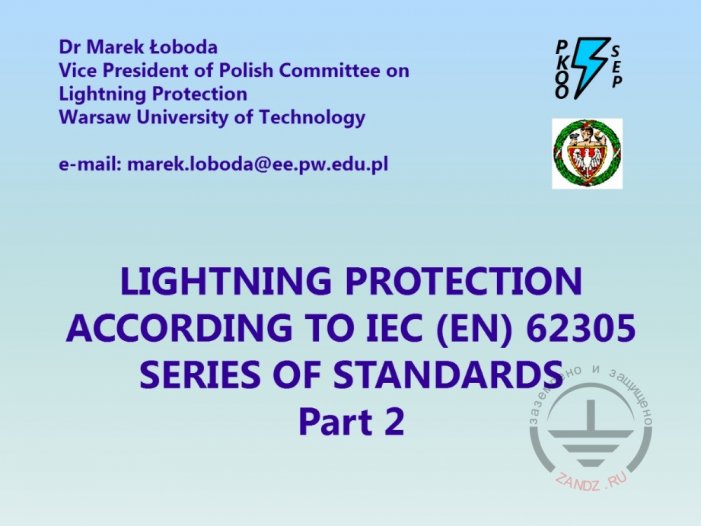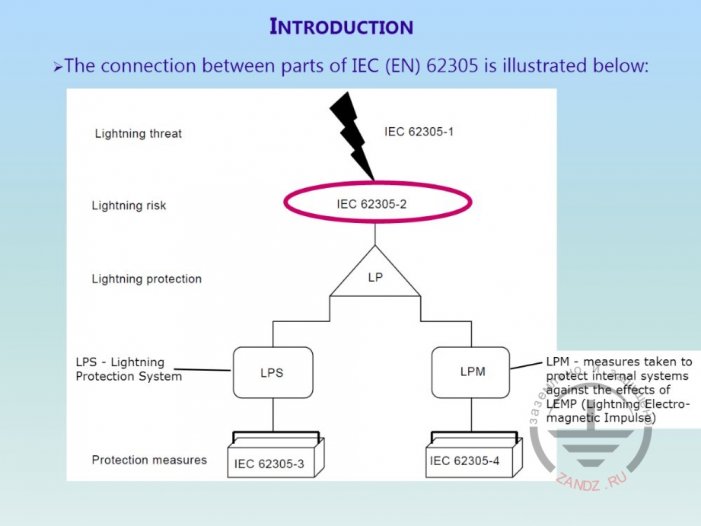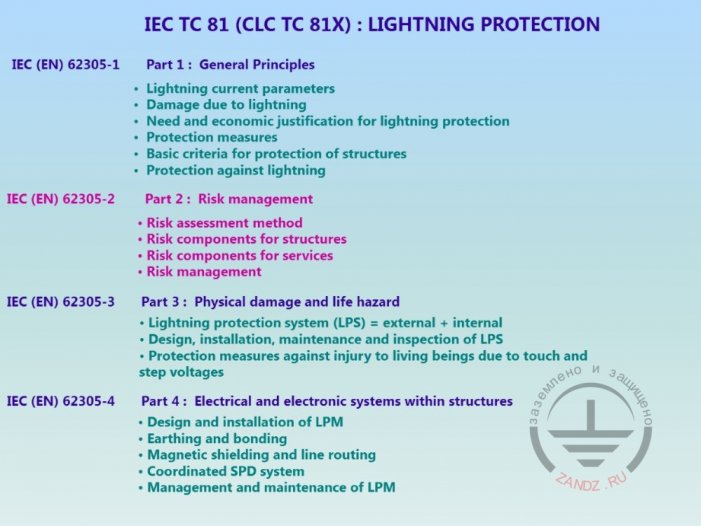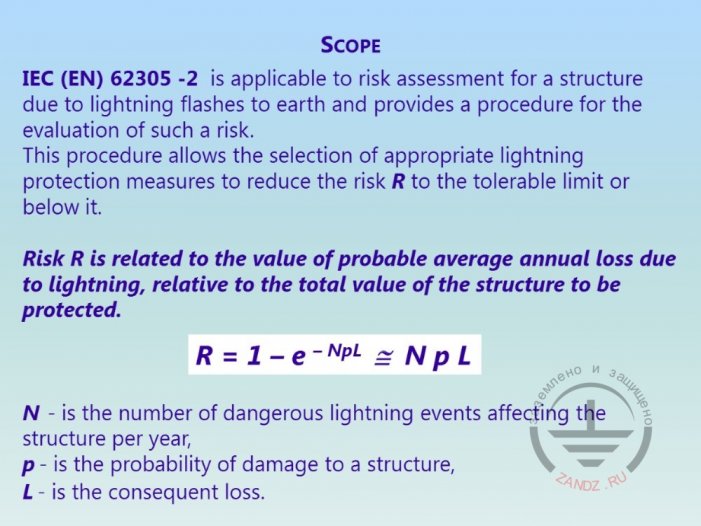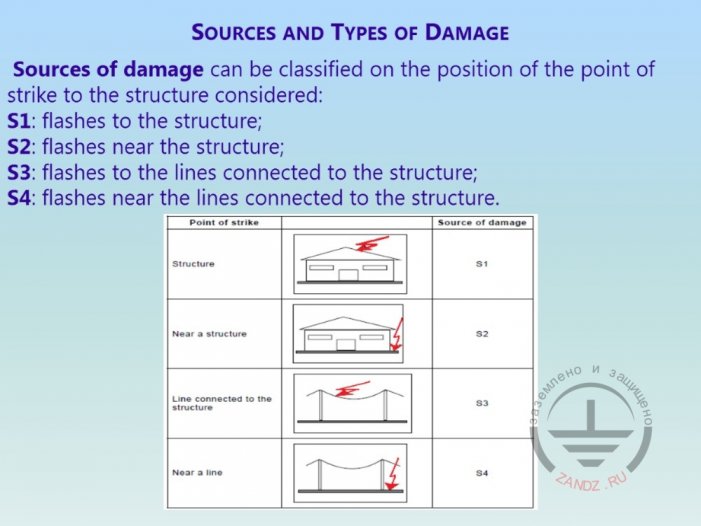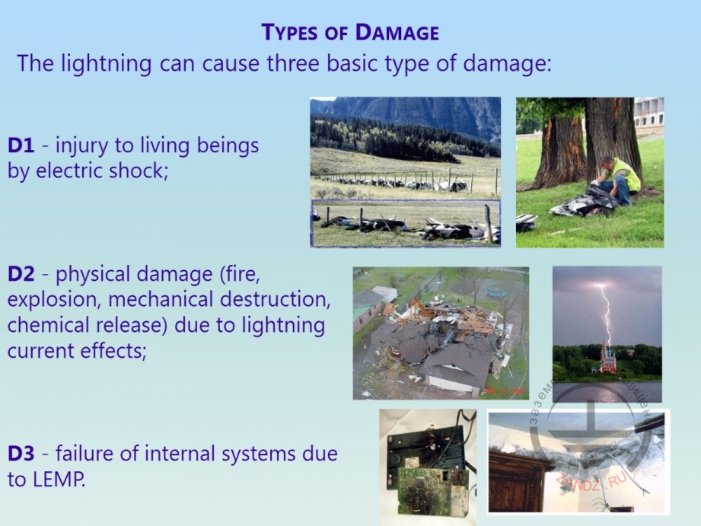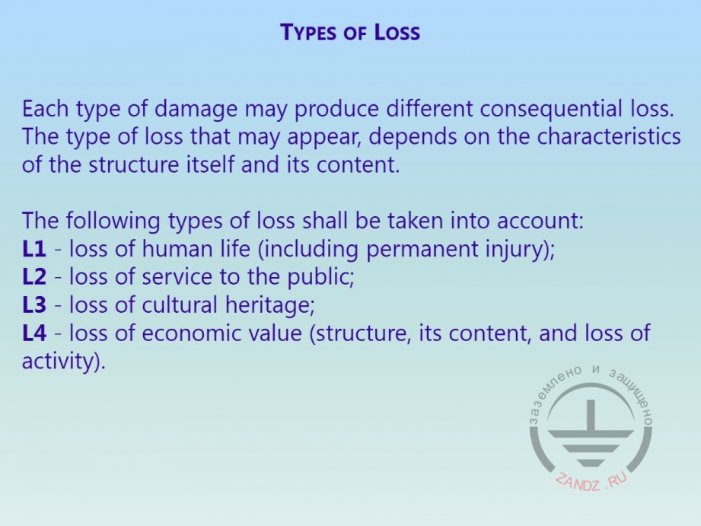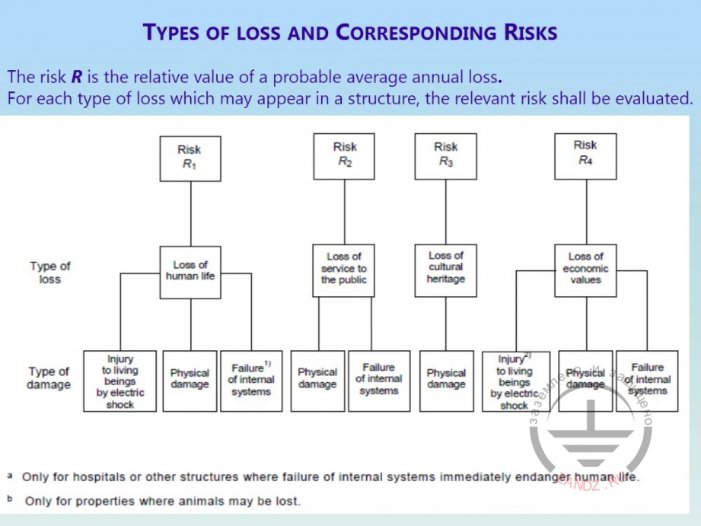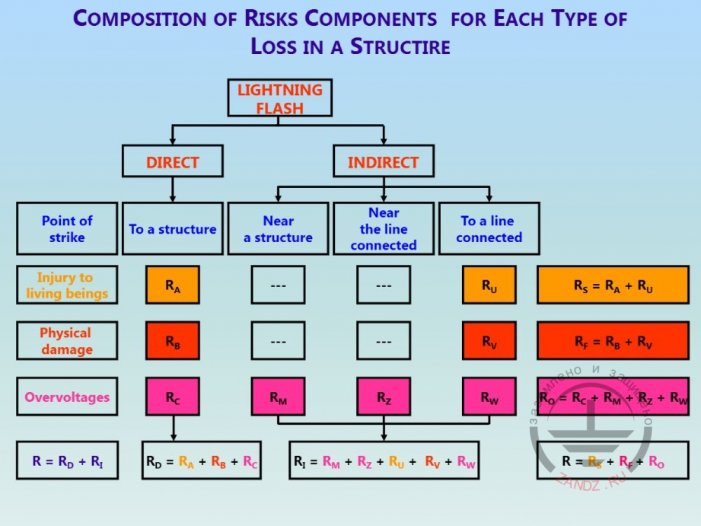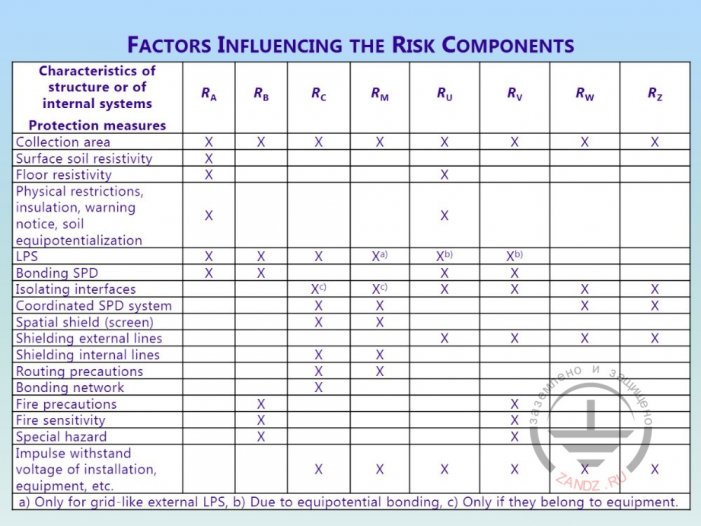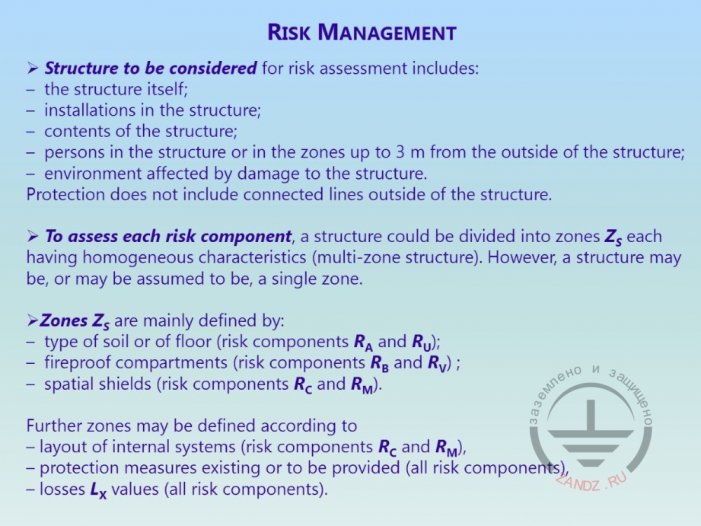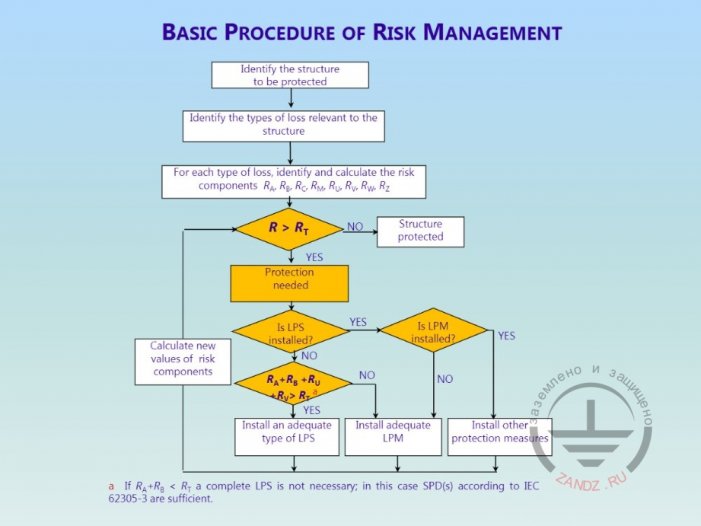The second webinar from the series "Grounding and lightning protection: International electro technical standard IEC 62305"
(was held on March 4, 2015 at 11:00 Moscow time)
We recommend watching with the quality of 1080p in a full-screen mode.
The following topics are covered in the "Risk management" section:
1. Procedures for the assessment of risk incurred by a lightning strike into a structure:
a) identification of the protected building (structure) and its characteristics;
b) identification of all types of losses in the building (structure), and the corresponding risk;
c) risk assessment for each type of loss;
d) risk assessment with an acceptable risk;
d) evaluation of protective measures feasibility by comparing the total amount of damage with or without protective measures. In this case, risk components estimation should be carried out in order to assess the damage.
2. Risk assessment objects, including: building (structure); equipment and installations in the building (structure); parts and content of the building (structure); presence of people in the building (structure), or in an area at the distance of 3 meters from the building (structure); environment affected by damage incurred by the building (structure).
The protection does not cover utility lines outside the building (structure).
3. Acceptable risk.
The document contains the values of acceptable risk in situations when a lightning strike could result in death and injury to people or losses due to the damage to facilities of social or cultural designation.
4. Procedures to assess the need for lightning protection.
In accordance with IEC 62305-1, in order to assess the need for lightning protection, it is necessary to analyze three types of risk, for each of which one needs to perform certain actions described in the document.
This section contains recommendations for cases when the risk cannot be reduced to an acceptable level and the danger of a lightning strike into the building (structure) extends to the surrounding area and the environment. This section also specifies the requirement for mandatory lightning protection measures for explosion-hazardous facilities.
5. Procedures to evaluate lightning protection feasibility.
In addition to assessing the need for lightning protection of a building, it is recommended to perform the calculation of lightning protection feasibility in order to reduce economic losses.
6. Lightning protection measures.
The protection measures are intended to reduce the risk and should be in line with the type of damage.
7. Choice of lightning protection measures.
Selection of appropriate lightning protection measures should be carried out at the design stage with consideration of the contribution of each risk component to the overall risk, as well as technical and financial aspects of the implementation of protection measures.
A separate subsection of the "Risk management" section sets forth rules and guidelines for assessing risk components for buildings.
Webinar text. Page 1
Quick navigation through slides:
Page 1:
1. International electro technical standard IEC 62305
2. Configuration of IEC standards
3. Common topics and parts of the standard
4. Risk calculation
5. List of possible lightning strike points
6. Types of damage
7. Types of losses from lightning
8. Analysis of lightning risks
9. Calculation and estimation of lightning protection components
10. Individual risk components
11. Risk management
12. Methodology of risk assessment
13. Admissible risk
14. Estimation of risk components
15. Estimation of lightning strikes density
16. Map of thunderstorms
17. Charge density on the ground in a certain point
18. Density of charges around the world
19. Calculation of lightning strikes density
20. Determination of lightning strikes square
21. Calculation methods
22. IIlumination system
23. Relative position of the structure
24. Factors of impacts on the equipment
25. Estimation of damage probability
26. Approximate values of damage probability
27. Classification of lightning protection systems
28. Calculation of internal systems failure probabilities
29. Risk of mortality and injury of people
30. Estimation of damage sum
31. Economical damage
32. Estimation of losses costs
33. Summary risk estimation
34. Risk estimation program
35. ALRISK software
36. Implementation of the third version of software
37. Questions and answers
Estimated reading time: 43 minutes
International electrotechnical standard IEC 62305. Part 2
— Good afternoon, dear colleagues. I think everybody is here; the rest will join us a bit later. We are delighted to welcome you at the new webinar dedicated to lightning protection design. And again Marek Loboda from Poland is with you. And the topic of the webinar today is "International electro technical standard IEC 62305. Risk management". My name is Alexey Korytko, I am an administrator of this webinar. You can find me in the list of participants at the bottom on the left. If you have questions on connection, adjustment of sound, you can send them to my chat. The chat is on the right. I will answer your questions. If you have answers to Marek, to the reporter, you can send them to the chat too and Marek will answer them. We will have a pause for questions between every block. Each block is 15 minutes. At first I recommend you to adjust the sound, so you could hear everybody well.
— In order to adjust the sound, you can click on the reporter's icon on the top left, where it is written - conference. If you point at Marek's icon, you will see volume regulator. You can adjust the level comfortable for you. We will also have a translator, who will join us soon and you can adjust his volume level too. We recommend you to adjust the volume level of the reporter to 50 and translator's level to 100. Because you will need to hear Russian speech first of all. If you have answers to Marek, to the reporter, during the report, you can send them to the chat too and Marek will answer them. I think you've set the volume. On the slide in the middle you see a manual how to set the volume. It's the same what I've said. I don't think anybody has troubles with this, so we can begin. I give the floor to Marek. Good afternoon, Marek!
Configuration of IEC standard
— Good afternoon to everybody! Greetings! It is Marek Loboda from Warsaw. I speak Russian, but the report will be in English, because my knowledge of Russian is not very good. In this lecture I concentrate on the second part of lightning protection standards, which are connected with risk management. I'd like to say a few words about keeping of standards connected with lightning protection. They are being constantly developed by the Technical Committee 81 of IEC and constantly supplemented. And today I will speak about the second edition, which was published in 2011 and 2012. However, we are working on 10th edition, which continues to develop. It is expected that it will be published in 2016.
General topics and parts of the standard
— Let's have a look at all four parts: common principles of risk assessment, physical injuries, life threat, and also electronic systems and structures. Today we'll be talking about risk management. However, it is planned that I would talk about part 3,4 at the next webinar.
Risk assessment
— I would like to focus my statement on risks connected with damage from lightning. There is a very short definition of this risk in the standard. The risk is connected with the values of average annual losses that happen because of lightning. And in its turn it is connected with the general value of structures, buildings or equipment, which should be protected. If you look at the formula, it is very simple. N, p, L - are designations here. And the general idea of risk assessment is based on the supposition, that people have no protection. And then of course there can be losses and damages. In this case, the probability is equal to 1. But there is another component - N, it is connected with the number and frequency of dangerous events, connected with lightning, and which happen at the structure or in the building once a year. And we can expect it once a year or once in several, for example, 6 years. Of course it depends on lightning frequency in certain geographical locations and on the lightning protection system. And the next risk component connected with the further losses. In my today's report I'd like to describe all three base components of risk, connected with lightning.
List of possible lightning strike points
—At first, I need to classify the sources of potential damaged caused by lightning. There happen different cases. The first one - is a lightning strike into a structure or building, and the second, is damage due a lightning strike near the building. In practice, it can be so, that it stands at the distance of 1000 meters or more from the structure. The third is when there is voltage line connected with this building or structure, and then a direct lightning strike hits this power line. There is also a danger for equipment inside the building and even damage to the building, if there is excessive voltage, which happens due to a lightning strike near power line.
Types of damage
— And subtypes of damage, they are connected with losses, injuries, which happen due to lightning. And of course, it is very important to avoid injuries to people which may occur due to electric shock. If there were people near the structure. Here you can see how. The first one - death of cows, this picture was made in Europe. And the second - human death due to a lightning strike. Out of 10 or 15 deaths, caused by lightning, only one third of them can be dangerous for a human being. I don't know all statistics in Russia, if lightning hit near.
Types of losses because of lightning
— There are types of losses, connected not only with money and economics, but with the loss of human life or health damage, or loss of services which are provided by various operators: telecommunication or electric entry supply to houses. And the third loss is connected with buildings that have high value in culture - the so-called cultural heritage.
Lightning risk assessment
— And of course we are working on the analysis of lightning risk and compare these components with types of losses and types of damage, which are shown on this picture. And it's a general view to the potential components, interconnected parameters of lightning risk.
Calculation and estimation of risk components
— But in order to make necessary calculations and estimate figures, values, we need to calculate and estimate the components of the whole system. These are direct and indirect risks.
Risk individual components
— And another chart connected with this standard. What is connected in this standard - individual risk components, but also interrelations with various possible protection methods, methodology and use of protection measures are described in detail in parts 3 and 4 of the standards. Here we see the parameters, which affect the individual risk components and may happen from a direct lightning strike or from lightning hitting at some small distance. On the whole, at the analysis it is important to learn what parameters influence directly or indirectly. And what risk could be minimized. We can also manage this risk on the base of description and estimation of each risk component.
Risk management
— But first, we need to characterize the building or structure and also installations inside the structures. And also the content, what is located inside the structures, everything depends on the number of people in this building or structure, or in such places, the so-called, zones. It can be, for example, inside the building or at the distance of three meters from the building. There can also happen an ecological impact of building's damage. And we need to estimate it, the impact to the environment. And it is a special topic, which is connected with losses, for example, chemical substances, which may be dangerous for environment. And in order to calculate and estimate lightning risk components, we need to divide the building or structure to separate zones. There can be homogeneous characteristics, in case of multi-zoning of the structure, presence of different zones. However, the structure can be homogeneous zone or we can suppose it is such. We are working on risk assessment. I will describe the details and I am interested in that. I think it is useful to define different zones here, as well as soil types, on which this building is standing and also material resistance or vice versa, conductivity of material under the floor, because it may also influence. Also parts protected from fire, the so-called fire proofed places, then we can reduce the risk and the number of risk components decreases and there can also be spatial shields.
Methodology of risk assessment
— This methodology of risk assessment is connected with the standardized approach and is quite a complex system. The main ideas are given in this algorithm, when in the beginning we need to identify the building or structure, which are going to protect from lightning. Also types of losses, which may happen in this building due to lightning due to the existing protection systems. And also clarify all risk subtypes. Here you see Rt- it means we are offering to estimate risk figures which are admissible for this building. If we consider that the risk is too high, and is higher the one accepted in the standard on Rt, then we make a decision to add protection. We are using LPS system that is lightning protection system or take measures on the protection for the interior part of the building for equipment and installations. Later you see, here, different risk components, which are connected with equipment and we can find adequate or appropriate types of lightning protection systems. On the whole, risk estimation algorithm uses the common standard.
Next Page >>
слайды с 13 по 26
Useful materials for designers::
- Webinars with the leading industry experts
- Everything for the calculation of grounding and lightning protection
- Useful materials: articles, recommendations, examples
Related Articles:


